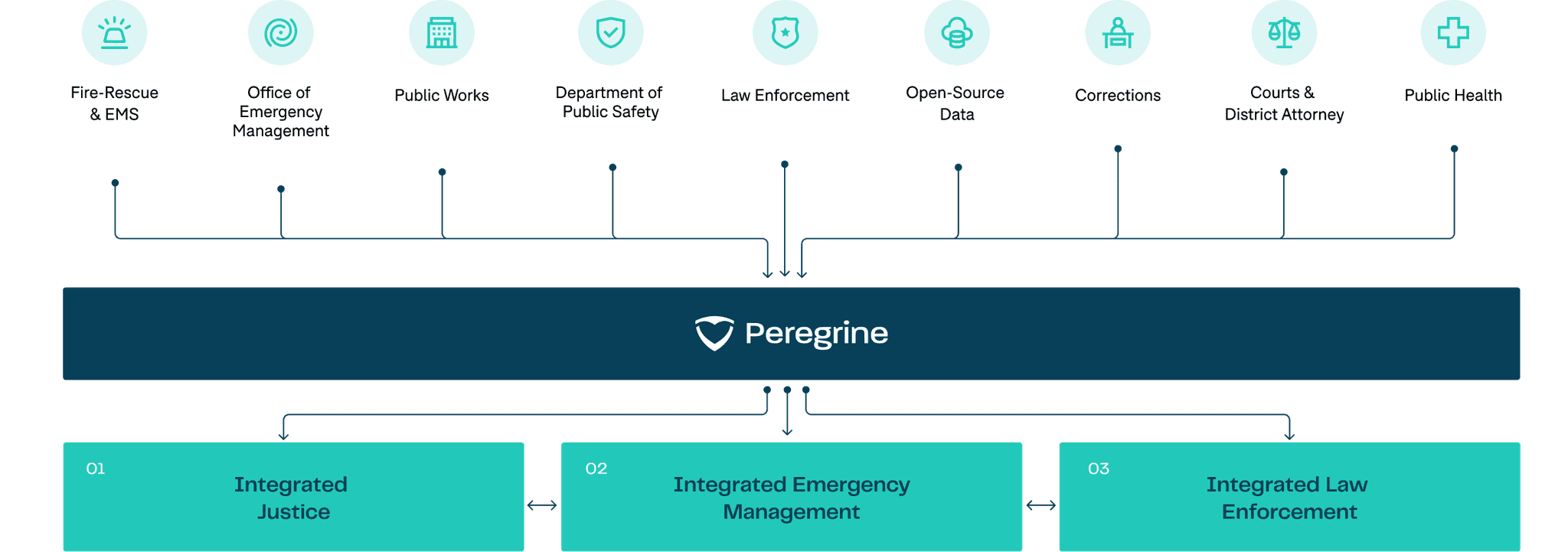How technology leaders deliver public safety outcomes
Kyle Stanko
June 25, 2024

Kyle Stanko
June 25, 2024

Data sharing as an ad hoc effort among agencies and departments is no longer sufficient given the demands to drive value from data and analytics. CIOs should focus on value-added and mission objectives when developing data-sharing initiatives. (Gartner 2023)
In a world of budget constraints, staffing shortages, and economic uncertainty, counties and cities are looking for their data to bridge the gap between where they are and where they strive to be, and communities are seeking data-driven results from their leaders. Technology leaders are answering the call and are more focused than ever on driving public safety outcomes for their constituents and communities, but they find themselves in a dizzying and seemingly endless landscape of software tools – all of which play some role in the “modern data stack.”
Enabling a “whole-of-government” approach to public safety across a county or city leads to safer and more just communities – but it’s easier said than done. This approach requires interagency data sharing to unlock data-driven community safety strategies. For example, agencies can allocate resources based on crime trends alongside real-time data on social services and infrastructure, ensuring timely and targeted interventions for crime prevention and emergency response. However, as interagency and interdepartmental data sharing expands, inevitably so does data volume, velocity, variety, and the demands on the underlying architecture.
The modern data stack is defined as a collection of tools and cloud data technologies used to collect, process, store, and analyze data. With extensive technical and financial resources, it's possible to construct a data stack by piecing together 10+ tools and platforms, but it will be a multi-year journey with many bumps in the road. Deploying and managing an end-to-end data management strategy is incredibly hard work and a tall order for any organization. Data must not only be extracted, ingested, transformed, stored, orchestrated, queried, analyzed, and visualized to provide actionable value but users must be able to intuitively leverage that data to solve specific problems. For many counties and cities, a growing, self-managed data stack becomes increasingly volatile and unwieldy, negatively impacting end users.
At Peregrine, we know there is a better way to ensure our most important institutions get to make data-driven progress without having to suffer from the volatility that leveraging data often brings.
Peregrine was born and raised in state and local government, and we spend 100% of our time focused on empowering our partners to solve their hardest problems and do their best work. It’s not just about managing data. It’s about developing a rich understanding and appreciation for the domain. It’s about getting in the trenches and peeling back layers of complexity to uncover the root causes of data challenges. It’s about working shoulder-to-shoulder with our users to understand, down to the click, how they interact with their agency’s data. We champion inquiry and exploration. We believe that curiosity is the catalyst for innovation. When it comes time to deploy the Peregrine platform, we are ready to configure it to your unique problems and start driving outcomes.

We enable our customers to harness the full potential of the modern data stack without the associated complexities and risks. Peregrine is a dynamic, full stack, data integration platform which ingests, transforms, enriches, and visualizes data of any type or scale in real-time. Configurable applications enable users to interact with the unified, enriched data to drive outcomes and achieve their missions. Our platform is built to be flexible – we say that the applications of our technology are as varied as the priorities and challenges facing our customers. So, when underlying source systems and missions change over time, Peregrine adapts. We sweat the details of each and every part of the data stack, so our customers don’t have to.
When the burden of managing data infrastructure is lifted off our customer’s shoulders, they are then empowered to ask and answer critical and previously intractable questions to enhance public safety.
How do we drive better outcomes throughout our justice system? How do we build a common operating picture so we can ensure community safety when disaster strikes? How do we use public safety and public health approaches to combat the opioid epidemic? These are questions that traverse systems, departments, agencies, and jurisdictional boundaries, and have historically been exceptionally difficult or impossible to answer. They require effective data sharing. They require being laser focused on mission objectives and outcomes rather than managing data infrastructure. They require a new way of thinking. Most of all, they require a technology partner to make it all possible.
We at Peregrine work tirelessly to build safe and just communities, and we look forward to doing the same for yours.